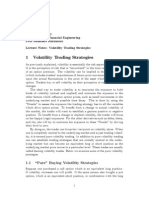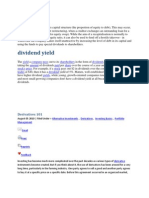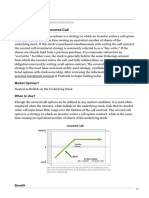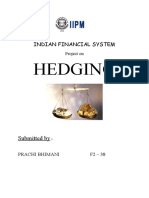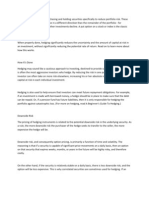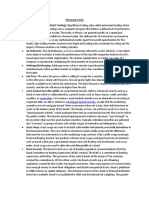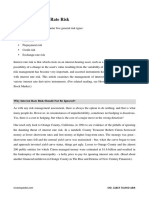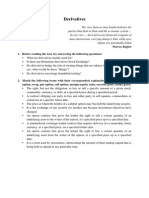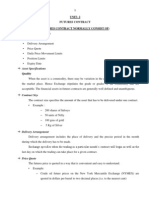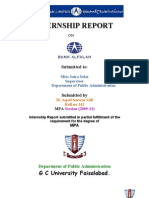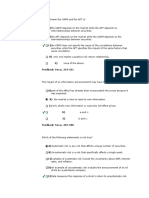Professional Documents
Culture Documents
Collar
Collar
Uploaded by
Yogesh SinghOriginal Description:
Copyright
Available Formats
Share this document
Did you find this document useful?
Is this content inappropriate?
Report this DocumentCopyright:
Available Formats
Collar
Collar
Uploaded by
Yogesh SinghCopyright:
Available Formats
CoIIar
Refers to the ceiling and floor of the price fluctuation of an underlying asset. A collar is usually set up
withoptions, swaps, or by other agreements. n corporate finance, the collar strategy of buying puts and
selling calls is often used to mitigate the risk of a concentrated position in (sometimes) restricted stock.
When the restricted owner can't sell the stock, but needs to diversify the risk, a collar transaction is one of
the few tools available. Many corporate executives who receive chunks of their compensation in restricted
stock need to employ this strategy to mitigate the diversification risk in their overall portfolio.
CoIIar
. A way to hedge against the potential of loss by buying an out-of-the-money put while writing an out-of-
the-money call. A collar is most beneficial when an investor holds a stock that has recently experienced
significant gains. f the stock falls, the investor can exercise the put, ensuring a profit. f it continues to
rise, the call places a cap on the profit.
2. On an exchange, a measure designed to prevent panic selling by stopping trading after a security or
anindex has fallen by a certain amount. For example, if the Dow Jones ndustrial Average falls in a
trading day, the New York Stock Exchange suspends trade for at least one hour. A collar is intended to
allow investors to determine whether a situation is really as bad as it looks. t is sometimes called a circuit
breaker. See also: Suspended trading.
Collar (Iinance)
O WIKIPEDIA
O Print
O Cite
O Share
n finance a .oIIar is an option strategy that limits the range of possible positive or negative returns
on an underlying to a specific range.
A collar is created by an investor being:
Long the underlying
long a put option at strike price X (called the "floor")
Short a call option at strike price (X+a) (called the "cap")
These latter two are a long Risk reversal position. So:
Underlying - Risk_Reversal = Collar
The premium income from selling the call reduces the cost of purchasing the put. The amount saved
depends on the strike price of the two options. f the premium of the long call is exactly equal to the
cost of the put, the strategy is known as a "zero cost collar". [Strictly speaking the name should be
"zero premium collar" as the cost of holding the position can be potentially high if the price of the
underlying rises above the strike level of the call.]
At expiration the value (but not the profit) of the collar will be:
zero if the price of the underlying is below X
positive if the price of the underlying is between X and (X + a)
The maximum value occurs for any price of the underlying above X+a.
ExampIe
Consider an investor who owns one hundred shares of a stock with a current share price of $5. An
investor could construct a collar by buying one put with a strike price of $3 and selling one call with a
strike price of $7. The collar would ensure that the gain on the portfolio will be no higher than $2 and
the loss will be no worse than $2 (before deducting the net cost of the put option, i.e., the cost of the
put option less what is received for selling the call option).
There are three possible scenarios when the options expire:
f the stock price is above the $7 strike price on the call he wrote, the person who bought the
call from the investor will exercise the purchased call; the investor effectively sells the
shares at the $7 strike price. This would lock in a $2 profit for the investor. He only makes a
$2 profit (minus fees), no matter how high the share price goes.
f the stock price drops below the $3 strike price on the put then the investor may exercise
the put and the person who sold it is forced to buy the investor's shares at $3. The
investor loses $2 on the stock, but can only lose $2 (plus fees), no matter how low the price
of the stock goes.
f the stock price is between the two strike prices at the expiration date, both options expire
unexercised, and the investor is left with the shares whose value is that stock price
(x), plus the cash gained from selling the call option, minus the price paid to buy the put
option, minus fees.
One source of risk is counterparty risk. f the stock price expires below the $3 floor then the
counterparty may default on the put contract, thus creating the potential for losses up to the full value
of the stock (plus fees).
n finance, the term "collar" usually refers to a risk management strategy called a "protective collar"; however, the use
of collars for other situations is less publicized. With a little effort and information, traders can use the collar concept
to manage risk and, in some cases, increase returns. This article will compare protective and bullish collar strategies
in terms of how they can help investors manage risk and increase returns. (To learn the basics to collars, see on't
Forget Your Protective Collar.)
ow Prote.tive CoIIars Work
This strategy is often used to hedge against risk of loss on a long stock position or an entire equity portfolio via the
use of index options. t can also be used to hedge interest rate movement by both borrowers and lenders
by using caps and floors.
Protective collars are considered a bearish to neutral strategy. The loss in a protective collar is limited, as is the
upside. Should the collared position increase above the strike price of the short call, the investor will lose the upside
potential - or suffer an opportunity cost. (To learn more about these collar basics, see our 5tions Basics tutorial.)
Read more: http://www.investopedia.com/articles/optioninvestor//protective-collar-bullish-collar.asp#ixzzasvrNZiF
nterest rate cap and floor
From Wikipedia, the free encyclopedia
An interest rate .ap is a derivative in which the buyer receives payments at the end of each period in which
the interest rate exceeds the agreed strike price. An example of a cap would be an agreement to receive a
payment for each month the LBOR rate exceeds 2.5.
Similarly an interest rate fIoor is a derivative contract in which the buyer receives payments at the end of each
period in which the interest rate is below the agreed strike price.
Caps and floors can be used to hedge against interest rate fluctuations. For example a borrower who is paying
the LBOR rate on a loan can protect himself against a rise in rates by buying a cap at 2.5. f the interest rate
exceeds 2.5 in a given period the payment received from the derivative can be used to help make the interest
payment for that period, thus the interest payments are effectively "capped" at 2.5 from the borrowers point of
view.
orward Rate Agreement - RA
What Does Forward Rate Agreement - FRA Mean?
An over-the-counter contract between parties that determines the rate of interest, or the currency
exchange rate, to be paid or received on an obligation beginning at a future start date. The contract will
determine the rates to be used along with the termination date and notional value. On this type of
agreement, it is only the differential that is paid on the notional amount of the contract.
Also known as a "future rate agreement".
Read more: http://www.investopedia.com/terms/f/fra.asp#ixzzaswC9eny
orward Rate Agreement
An agreement between two parties to exchange two currencies or interest rates at a given rate at some
point in the future. A forward rate agreement mitigates foreign exchange risk or interest rate risk for the
parties. t is most useful when both parties have operations or some other interest in a country using a
given currency or investment vehicle with a floating interest rate. Forward rate agreements are over-the-
counter contracts and are also called future rate agreements.
Cap
An upper limit on the interest rate on a floating-rate note (FRN) or an adjustable-rate mortgage (ARM).
Also, an OTC derivatives contract consisting of a series of European interest rate call options; used to
protect an issuer of floating-rate debt from interest rate increases. Each individual call option within the
cap is called a caplet. Opposite of a floor.
cap
An upper limit (same as ceiling), or to set an upper limit. n finance, this is normally used with respect
to interest rates. n the bond market, for instance, an issuer may cap the yield on a floating rate note
(capped note). A bank may cap the interest rate charged on an adjustable rate mortgage. A cap is
also an interest rate derivative that pays money to its holder if the underlying interest rate goes
above an agreed strike level. Cap is also short for market capitalisation, the total market value of a
company's issued shares. Stocks can be referred to as small-cap, mid-cap or large-cap.
You might also like
- Volatility Trading StrategiesDocument16 pagesVolatility Trading StrategiesAvik Banerjee100% (2)
- Hedging PDFDocument6 pagesHedging PDFIraiven ShanmugamNo ratings yet
- Investment Memo For DeloitteDocument6 pagesInvestment Memo For Deloitteblackpearl192No ratings yet
- P2.T5. Market Risk Measurement & Management Bionic Turtle FRM Practice Questions Sample Kevin Dowd, Measuring Market RiskDocument6 pagesP2.T5. Market Risk Measurement & Management Bionic Turtle FRM Practice Questions Sample Kevin Dowd, Measuring Market RiskAnkur BhartiyaNo ratings yet
- Derivatives NotesDocument9 pagesDerivatives NotesJoie JohnsonNo ratings yet
- Forex - : Corporate Hedge ToolsDocument15 pagesForex - : Corporate Hedge ToolsJai GuptaNo ratings yet
- What Is A Bear Put Spread?: Trader Strike Price ExpirationDocument17 pagesWhat Is A Bear Put Spread?: Trader Strike Price ExpirationShubham RajNo ratings yet
- Financial Engineering & Risk Management: Unit - VDocument16 pagesFinancial Engineering & Risk Management: Unit - VPrakash ChoudharyNo ratings yet
- Chapter 6Document5 pagesChapter 6Muhammed YismawNo ratings yet
- Derivatives ManagementDocument13 pagesDerivatives ManagementMaharajascollege KottayamNo ratings yet
- Dividend Yield: RecapitalisationDocument6 pagesDividend Yield: RecapitalisationArun NadarNo ratings yet
- Options Guide: Options Strategies: Covered CallDocument3 pagesOptions Guide: Options Strategies: Covered CallLamico DellavvoltoioNo ratings yet
- Futures Contracts FinalDocument11 pagesFutures Contracts Finalravi_nyseNo ratings yet
- Basis Risk, Options Risk, Structure Risk, and Repricing Risk.Document4 pagesBasis Risk, Options Risk, Structure Risk, and Repricing Risk.Puja DuaNo ratings yet
- Answers To Chapter 10 QuestionsDocument7 pagesAnswers To Chapter 10 QuestionsLe QuangNo ratings yet
- Butterfly SpreadDocument42 pagesButterfly Spreadankit_21100% (1)
- Derivatives Project MIHIRDocument14 pagesDerivatives Project MIHIRYogesh KambleNo ratings yet
- Study Notes Trading StrategiesDocument16 pagesStudy Notes Trading Strategiesalok kundaliaNo ratings yet
- Interest Rate CollarDocument3 pagesInterest Rate Collarinaam mahmoodNo ratings yet
- Derivatives and RMDocument35 pagesDerivatives and RMMichael WardNo ratings yet
- Currency Options: Trading & SpeculationDocument11 pagesCurrency Options: Trading & SpeculationNelly NanevaNo ratings yet
- WORK SHEET - Financial Derivatives: Q1) Enumerate The Basic Differences Between Forward and Futures ContractsDocument5 pagesWORK SHEET - Financial Derivatives: Q1) Enumerate The Basic Differences Between Forward and Futures ContractsBhavesh RathiNo ratings yet
- Financial Security: Best Online Brokers)Document7 pagesFinancial Security: Best Online Brokers)Khabele LenkoeNo ratings yet
- Hedging - PrachiDocument15 pagesHedging - PrachiPrachi_Bhimani_1721No ratings yet
- 2019-Ag-1826 Zain Ul AbidinDocument9 pages2019-Ag-1826 Zain Ul AbidinMian ZainNo ratings yet
- Hedging AnalysisDocument8 pagesHedging AnalysisdhananjaybookNo ratings yet
- FM NotesDocument10 pagesFM NotesYashi SharmaNo ratings yet
- Definition of 'Stop-Loss Order'Document25 pagesDefinition of 'Stop-Loss Order'Siddharth MehtaNo ratings yet
- Caps and FloorsDocument4 pagesCaps and FloorsSanya rajNo ratings yet
- Greeks: Type Delta Value Profits When..Document6 pagesGreeks: Type Delta Value Profits When..Anurag SinghNo ratings yet
- Qus Der Mid 1Document4 pagesQus Der Mid 1Santosh KumarNo ratings yet
- Derivatives: You Need To Know About Derivatives TradingDocument35 pagesDerivatives: You Need To Know About Derivatives TradingPooja mahadikNo ratings yet
- Algorithmic Trading (ALGO Trading) : Algorithmic Trading (Also Called Automated Trading, BlackDocument5 pagesAlgorithmic Trading (ALGO Trading) : Algorithmic Trading (Also Called Automated Trading, BlacksamikhanNo ratings yet
- Study Notes On DerivativesDocument13 pagesStudy Notes On DerivativesAbrar Ahmed100% (2)
- ExercisesDocument5 pagesExerciseslurjnoaNo ratings yet
- Exotics: DerivativesDocument21 pagesExotics: DerivativesSidharth ChoudharyNo ratings yet
- Margin (Finance)Document6 pagesMargin (Finance)BOBBY212No ratings yet
- Derivatives 101Document30 pagesDerivatives 101sv798dctq9No ratings yet
- Notes F.D. Unit - 3Document14 pagesNotes F.D. Unit - 3kamya saxenaNo ratings yet
- Managing Interest Rate RiskDocument4 pagesManaging Interest Rate RiskNyeko FrancisNo ratings yet
- Quiz Bomb FDDocument12 pagesQuiz Bomb FDTshering Pasang SherpaNo ratings yet
- FIN 010 DerivativesDocument4 pagesFIN 010 DerivativesChristine CaridoNo ratings yet
- Derivatives FinalDocument37 pagesDerivatives FinalmannashkshitigarNo ratings yet
- Derivatives: 1. Before Reading The Text, Try Answering The Following QuestionsDocument6 pagesDerivatives: 1. Before Reading The Text, Try Answering The Following QuestionsAdina MihaelaNo ratings yet
- Stock ExchangeDocument16 pagesStock Exchange03459143301No ratings yet
- Orca Share Media1517752297941Document179 pagesOrca Share Media1517752297941Jewel Mae MercadoNo ratings yet
- Ratio Back SpreadsDocument20 pagesRatio Back SpreadsOladipupo Mayowa PaulNo ratings yet
- Answers To Chapter 10 QuestionsDocument10 pagesAnswers To Chapter 10 QuestionsMoNo ratings yet
- Collar: Montréal ExchangeDocument3 pagesCollar: Montréal ExchangepkkothariNo ratings yet
- Introduction To The Basic Concept of Derivatives: Over-The-Counter Market Mean?Document6 pagesIntroduction To The Basic Concept of Derivatives: Over-The-Counter Market Mean?Aman NegiNo ratings yet
- Learning Outcomes: 2.1 OptionsDocument10 pagesLearning Outcomes: 2.1 OptionsRajesh GargNo ratings yet
- Glossory A AccumulationDocument33 pagesGlossory A AccumulationAmit KumarNo ratings yet
- Options StrategiesDocument12 pagesOptions StrategiesVittalDass143 VittalNo ratings yet
- 3.1 FuturesDocument18 pages3.1 Futuresarpitmittal07No ratings yet
- 7A - Derivatives - FullDocument65 pages7A - Derivatives - FullWasalle GeseseNo ratings yet
- Derivatives and Commodity ExchangesDocument53 pagesDerivatives and Commodity ExchangesMonika GoelNo ratings yet
- Cash Backed CallDocument3 pagesCash Backed CallpkkothariNo ratings yet
- Bcom Finance DrivitesDocument10 pagesBcom Finance DrivitesVivek GabbuerNo ratings yet
- Futures ContractDocument15 pagesFutures Contractitika jainNo ratings yet
- Unit-2 Futures Contract Specifications of Futures Contract Normally Consist ofDocument20 pagesUnit-2 Futures Contract Specifications of Futures Contract Normally Consist ofUthra PandianNo ratings yet
- OPTIONS TRADING: Mastering the Art of Options Trading for Financial Success (2023 Guide for Beginners)From EverandOPTIONS TRADING: Mastering the Art of Options Trading for Financial Success (2023 Guide for Beginners)No ratings yet
- Determination of Exchange Rates & Balance of PaymentsDocument15 pagesDetermination of Exchange Rates & Balance of PaymentsBivek DahalNo ratings yet
- The Net Profit of A Manufacturing CoDocument15 pagesThe Net Profit of A Manufacturing CosachinremaNo ratings yet
- WiproDocument12 pagesWiprovanitasunilNo ratings yet
- Alternative FinanceDocument43 pagesAlternative FinancePragathi SundarNo ratings yet
- Course Code:8503 Unit # 01: EntrepreneurshipDocument29 pagesCourse Code:8503 Unit # 01: EntrepreneurshipSalaha AbdullahNo ratings yet
- Final Copy of Bank Alfalah ProjectDocument58 pagesFinal Copy of Bank Alfalah ProjectAqeel GillNo ratings yet
- G.R. No. L-45911 - Gokongwei, Jr. v. Securities and ExchangeDocument46 pagesG.R. No. L-45911 - Gokongwei, Jr. v. Securities and ExchangeKaren Gina DupraNo ratings yet
- Financial Analysis and Valuation PICAVET ValentinDocument26 pagesFinancial Analysis and Valuation PICAVET ValentinValentin PicavetNo ratings yet
- Smart Habitota GreencascadeDocument7 pagesSmart Habitota GreencascadeMaheshwar ReddyNo ratings yet
- Akash Finsoc CAP4Document3 pagesAkash Finsoc CAP4Akash DidhariaNo ratings yet
- AMFI ReportsDocument100 pagesAMFI ReportsRavi KumarNo ratings yet
- Analyzing Gaps For Profitable Trading StrategiesDocument31 pagesAnalyzing Gaps For Profitable Trading StrategiestenglumlowNo ratings yet
- Accrual vs. Cash AccountingDocument33 pagesAccrual vs. Cash AccountingAbhishek ShetyeNo ratings yet
- Accounting Standard - 20 Earning Per Share Full NotesDocument16 pagesAccounting Standard - 20 Earning Per Share Full NotesKumar SwamyNo ratings yet
- UPSA 2019 Tutorial Questions Fs WITH ANSWERSDocument14 pagesUPSA 2019 Tutorial Questions Fs WITH ANSWERSLaud ListowellNo ratings yet
- International Business Environments and Operations, 13/e Global EditionDocument20 pagesInternational Business Environments and Operations, 13/e Global EditionAndres Francisco ParejaNo ratings yet
- SahooCommittee Ecbreport 20150225Document109 pagesSahooCommittee Ecbreport 20150225advpreetipundirNo ratings yet
- CT Far160 Dec2022 QDocument4 pagesCT Far160 Dec2022 QSiti Nurul AtiqahNo ratings yet
- Accounting Anaylis and Interpretation of InformationDocument80 pagesAccounting Anaylis and Interpretation of InformationBoogy Grim100% (1)
- BYD Company LimitedDocument7 pagesBYD Company LimitedYograj Singh ChauhanNo ratings yet
- Annual Report 2016 - Part 3 Airasia)Document173 pagesAnnual Report 2016 - Part 3 Airasia)LucyChanNo ratings yet
- Business FinanceDocument8 pagesBusiness FinanceLesley DenisNo ratings yet
- CF1 5Document11 pagesCF1 5ANZNo ratings yet
- High Probability ETF Trading 7 Professional Strategies To Improve Your ETF Trading by Larry Connors, Cesar Alvarez, Connors Research LLCDocument136 pagesHigh Probability ETF Trading 7 Professional Strategies To Improve Your ETF Trading by Larry Connors, Cesar Alvarez, Connors Research LLCpetruzzellikelley100% (1)
- Add Math Project Work 2/2013Document14 pagesAdd Math Project Work 2/2013aditas san100% (2)
- Cap3. Quantitative Problem Part1Document2 pagesCap3. Quantitative Problem Part1Prof. LUIS BENITEZNo ratings yet
- The 2017 HBCU@SXSW Partnership PresentationDocument38 pagesThe 2017 HBCU@SXSW Partnership PresentationRodney SampsonNo ratings yet
- Lecture 8-1-19032016 INPUT Mixed Method Levered UnleveredDocument16 pagesLecture 8-1-19032016 INPUT Mixed Method Levered UnleveredLeroy AlicandroNo ratings yet
